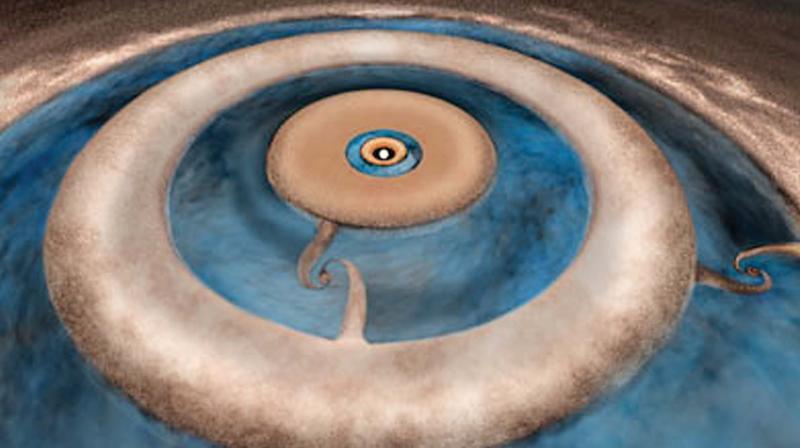Scientists find new solar system 400 light years away from Earth

Chennai: In one of the exciting findings in the field of astronomy, scientists with the help of a powerful ALMA telescope in Chile have observed the formation of a new solar system, some 400 light years away from the Earth.
This observation gives the opportunity for the astronomers to directly witness the birth of planets. The evidence shows that two newborn planets, each about the size of Saturn, are in orbit around a young star known as HD 163296. It is located approximately 400 light-years from Earth in the direction of the constellation Sagittarius.
These planets, which are not yet fully formed, revealed themselves by the dual imprint they left in both the dust and gas portions of the star’s protoplanetary disk.
“Atacama Large Millimetre/submillimeter Array (ALMA) has shown us amazing images and never-before-seen views of the rings and gaps around young stars that could be the hallmarks of planet formation,”said Andrea Isella, an astronomer at Rice University in Houston, Texas and lead author on a paper published in Physical Review Letters.
In studying HD 163296, the research team used ALMA to trace, for the first time, the distribution of both the dust and the carbon monoxide (CO) gas components of the disk at roughly the same level of detail.
These observations revealed three distinct gaps in HD 163296’s dust-filled protoplanetary disk. The first gap is located approximately 60 astronomical units from the central star, which is about twice the distance from our Sun to Neptune. (An astronomical unit – AU – is the average distance from the Earth to the Sun.) The other two gaps are 100 AU and 160 AU from the central star which is roughly five million years old.
Using ALMA’s ability to detect the faint millimetre-wavelength “glow” emitted by gas molecules, Isella and his team discovered that there was also an appreciable dip in the amount of CO in the outer two dust gaps.
By seeing the same features in both the gas and the dust components of the disk, the astronomers believe they have found compelling evidence that there are two planets coalescing remarkably far from the central star. The width and depth of the two CO gaps suggest that each potential planet is roughly the same mass as Saturn.
“Our results indicate that there are two planets with a mass similar to that of Saturn orbiting at 100 and 160 AU from a young star,” Andrea Isella told Deccan Chronicle.
He said it implies that planets can form very far away from their host star. The general consensus is that planet from between 1- 10 AU from the star. These planets are 10 times and 100 times further away from their host star.
Scientists also believe that it will reveal the details of the formation of our own solar system. “Our solar system is 4.5 billion years old. The planets in the solar system might have moved away from their birthplaces stirring up by asteroids and comets.
The study and exploration of the solar system can, therefore, provide limited information about its origin. Instead, we have now the opportunity to image planetary systems in the formation and directly witness the birth of planets,” he concluded.

